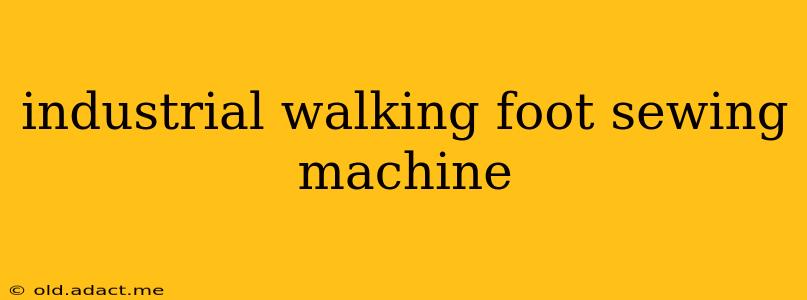Industrial walking foot sewing machines are workhorses in various industries, renowned for their durability and ability to sew heavy-duty materials with precision. This comprehensive guide explores their features, applications, and considerations when choosing one for your needs. We'll delve into the specifics, addressing common questions and offering valuable insights for both seasoned professionals and newcomers alike.
What is an Industrial Walking Foot Sewing Machine?
An industrial walking foot sewing machine is a robust sewing machine designed for heavy-duty sewing applications. Unlike domestic sewing machines, it features a specialized "walking foot," which moves the fabric evenly from both the feed dogs (located beneath the needle plate) and the walking foot itself. This synchronized movement prevents slippage and ensures consistent stitching, especially crucial when working with thick, multiple layers of fabric, or difficult-to-handle materials like leather, canvas, or vinyl. These machines are built for longevity, often featuring all-metal construction and powerful motors capable of handling demanding tasks.
What are the Benefits of Using an Industrial Walking Foot Sewing Machine?
The primary advantage of an industrial walking foot sewing machine lies in its superior feeding mechanism. This eliminates fabric slippage, a common problem with standard sewing machines, particularly when sewing thick materials or multiple layers. Other benefits include:
- Increased Productivity: The consistent feed and powerful motor significantly increase stitching speed and overall productivity.
- Superior Stitch Quality: The even feed results in consistent stitch length and tension, leading to professional-looking seams.
- Versatility: While renowned for heavy-duty applications, many models can handle a range of fabrics and thicknesses.
- Durability: Built with robust components, these machines are designed for years of reliable operation.
- Reduced Operator Fatigue: The smoother feeding mechanism reduces the strain on the operator.
What Types of Materials are Best Suited for an Industrial Walking Foot Sewing Machine?
The versatility of an industrial walking foot sewing machine is one of its greatest assets. They excel at sewing:
- Heavy-duty fabrics: Leather, canvas, denim, upholstery fabrics, and other thick materials are easily handled.
- Multiple layers: Sewing multiple layers of fabric, such as in quilting or garment construction, is accomplished without bunching or shifting.
- Difficult-to-handle fabrics: Materials that tend to stretch or slip during sewing, such as vinyl or nylon, are sewn with precision.
How Does a Walking Foot Differ from a Regular Presser Foot?
A standard presser foot only moves the fabric through the feed dogs beneath the needle plate. This can lead to slippage, especially when sewing difficult-to-handle fabrics or multiple layers. A walking foot, however, features a set of feed dogs that mirrors the motion of the feed dogs underneath. This synchronized movement prevents fabric slippage, feeding the fabric evenly from both the top and bottom. The result is a much more even and consistent stitch.
What are the Different Types of Industrial Walking Foot Sewing Machines?
Industrial walking foot sewing machines come in various configurations depending on the specific needs of the application. Some key distinctions include:
- Single needle vs. double needle: Single-needle machines are versatile, while double-needle machines are ideal for creating double seams quickly.
- Direct drive vs. belt drive: Direct-drive machines offer more precise speed control and smoother operation, while belt-drive machines are often more affordable.
- Needle types and sizes: The type and size of needle used are determined by the material being sewn.
How to Choose the Right Industrial Walking Foot Sewing Machine?
Selecting the right industrial walking foot sewing machine involves considering several factors:
- Type of materials to be sewn: The thickness and type of fabric will dictate the required machine power and features.
- Sewing volume: The anticipated volume of sewing will influence the need for speed and durability.
- Budget: Industrial sewing machines range in price, so it's important to set a realistic budget.
- Maintenance and support: Choose a reputable brand with readily available parts and service.
How Much Does an Industrial Walking Foot Sewing Machine Cost?
The cost of an industrial walking foot sewing machine can vary significantly depending on the brand, features, and capabilities. Expect to invest a substantial amount, generally ranging from several hundred to several thousand dollars. The long-term value and increased productivity often justify the higher initial cost.
This comprehensive guide provides a solid foundation for understanding industrial walking foot sewing machines. Remember to research specific models and consider your individual needs before making a purchase. The right machine can significantly improve your efficiency and the quality of your work.
